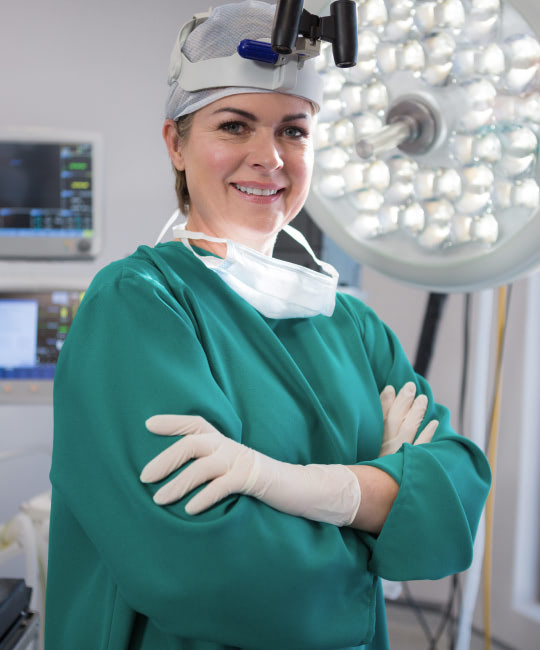Laser Hair Reduction
At AA Dermascience, we revolutionize the concept of beauty with our state-of-the-art Diode laser hair reduction services. Bid farewell to unwanted body hair as our cutting-edge laser technology, coupled with expert care, ensures a transformative experience. Utilizing the latest laser systems, we guarantee safe, efficient, and enduring results. By precisely targeting hair follicles, our advanced technology obliterates them at the root, all while preserving the surrounding skin. The outcome? Soft and smooth skin with minimal discomfort and recovery time.
How Does Laser Hair Reduction Work?
The Diode laser emits a specific wavelength of light absorbed by the melanin in hair follicles, the pigment responsible for hair coloration. This laser energy selectively targets the hair follicles, leaving the surrounding skin unscathed. Upon absorption, the laser energy converts into heat, damaging the hair follicle’s structure and impending future hair growth. The precise targeting of melanin ensures the surrounding skin remains cool and protected. Tailored treatment plans address individual needs, ensuring safety and comfort throughout the process. Our clinic adheres to strict safety protocols, prioritizing your experience.

Why Are Multiple Sessions Required?
Hair growth occurs in different stages, with the Diode laser most effective during the active growth phase (anagen). Since not all hair follicles are in this phase simultaneously, multiple sessions are necessary to effectively target them. With each session, targeted hair follicles are progressively damaged, leading to a gradual reduction in hair growth and finer, lighter hair over time. While significant reduction is achieved, periodic maintenance sessions may be required.
Indications for Laser Hair Reduction:
Beyond cosmetic purposes, laser hair reduction is beneficial for various dermatological conditions:
- Hirsutism: Excessive hair growth in women, particularly in areas with minimal hair presence.
- Pseudofolliculitis Barbae: Commonly known as ingrown hairs, laser treatment can alleviate discomfort and prevent future occurrences.
- Hypertrichosis: Excessive hair growth where terminal hair doesn’t typically grow.
- Trichostasis Spinulosa: Reduction of fine hairs within hair follicles, improving skin texture.
- Pilonidal Cysts: Prevention of cyst development in the sacrococcygeal region, reducing recurrence risk.
- Adjunctive Treatment: Supporting various dermatological conditions exacerbated by excessive hair growth.
Contraindications
Prior to treatment, we conduct thorough consultations to assess suitability. Contraindications include pregnancy/breastfeeding, certain photosensitive dermatological conditions, history of keloid scarring, or active infections.
Post-Procedure Instructions:
Aftercare is crucial for optimal results and minimizing complications:
Protect from sunlight and tanning beds. Avoid heat and excessive sweating. Use mild skincare products and gentle cleansing. Wear loose, breathable clothing. Refrain from other hair removal methods between sessions. Expect mild side effects like redness and swelling, which typically resolve within a few days.
FAQ’s
1. How does laser hair reduction operate?
Laser hair reduction functions by directing concentrated light energy onto the pigment within the hair follicle. This laser procedure works by damaging the follicle, and hindering future hair growth.
2. Is laser hair reduction a safe procedure?
Yes, laser hair reduction is typically safe when conducted by a qualified and experienced practitioner. However, potential risks and side effects will be thoroughly discussed during your consultation.
3. Does laser hair reduction cause discomfort?
Many individuals experience minimal discomfort during laser hair reduction, often likened to a snapping or stinging sensation. Nonetheless, pain tolerance varies, and topical numbing creams can be applied before treatment to alleviate discomfort.
4. How many sessions are necessary for optimal outcomes?
The number of sessions required varies based on factors like hair color, skin type, and treatment area. Generally, 6-8 sessions spaced over several weeks are recommended to achieve optimal results.
5. What is the longevity of laser hair reduction results?
Laser hair reduction can yield long-term reductions in hair growth, although outcomes vary among individuals. Some may achieve permanent hair reduction, while others may require occasional maintenance sessions to sustain results.
6. Is there any recovery time after laser hair reduction?
Typically, minimal downtime follows laser hair reduction. Mild redness or swelling in the treated area may occur, resolving within hours to days. Patients can resume their daily routine activities immediately post-treatment.
7. Are there any potential side effects associated with laser hair reduction?
Though rare, possible side effects may include temporary redness, swelling, itching, or alterations in skin pigmentation. These effects are normally minor and temporary.
8. Which body areas can undergo laser hair reduction?
Laser hair reduction is applicable to nearly all body parts, including the face, arms, legs, underarms, bikini area, chest, back, and more.
9. How should I prepare for my laser hair reduction procedure?
Before treatment, you may be advised to avoid sun exposure and cease hair removal methods like waxing or plucking for at least two weeks.
Our Achievement











Request For Consultation
- Housing Board Colony, Jharsa Road, Sector- 15 Gurugram Haryana 122001
- +91 9711177196
- 0124-4361316
- C-502 5th Floor Nirvana Courtyard Nirvana Country Sector 50 Gurugram haryana - 122018
- +91 9811480877
- 0124-4280111
Copyright. © 2025 • AA Derma Science Inc. All rights reserved.





